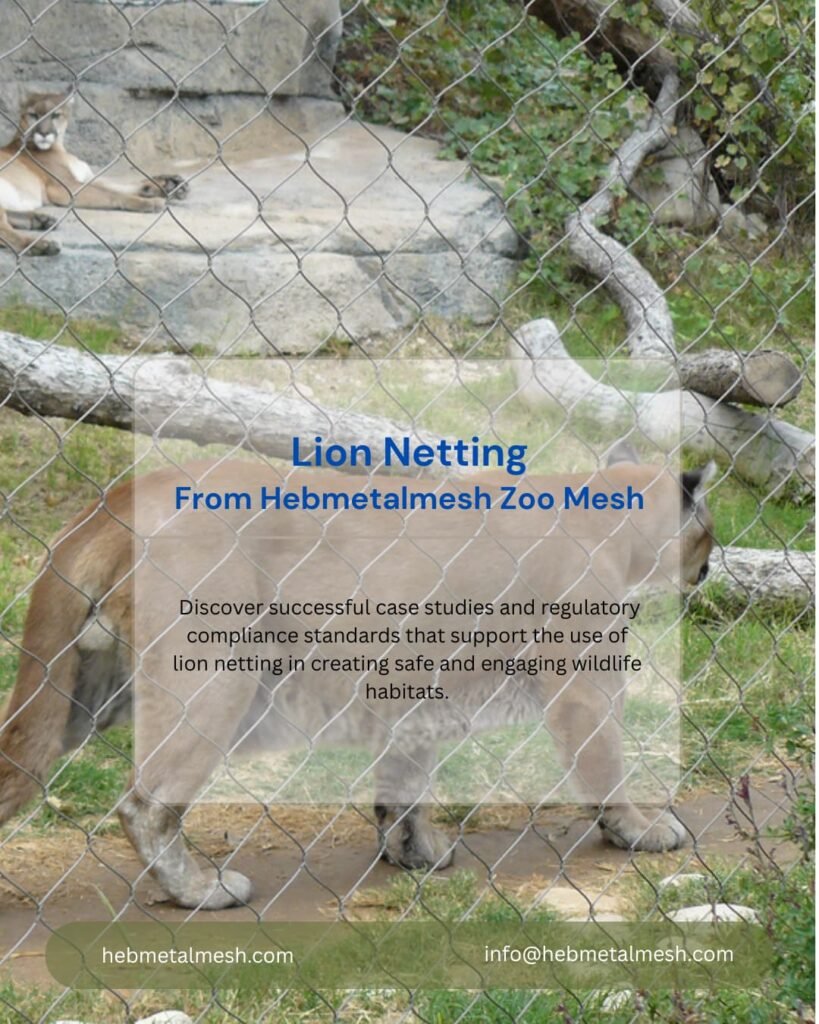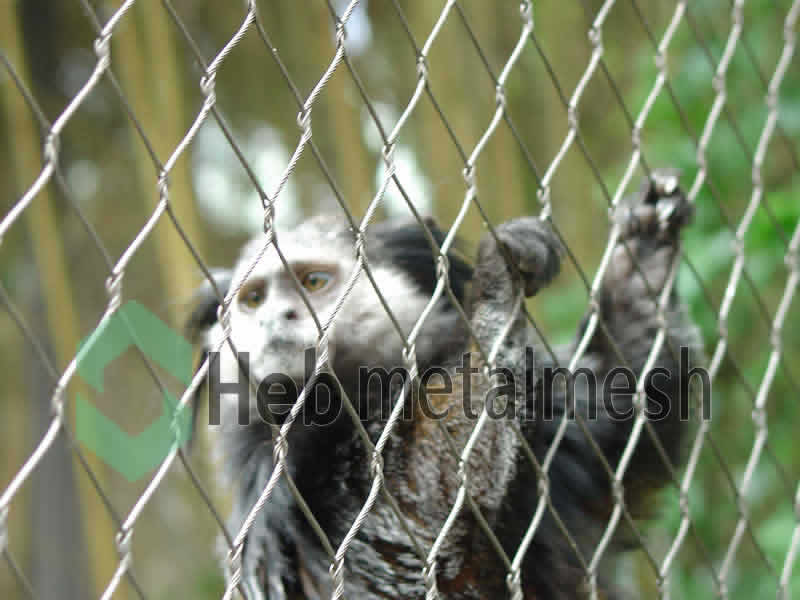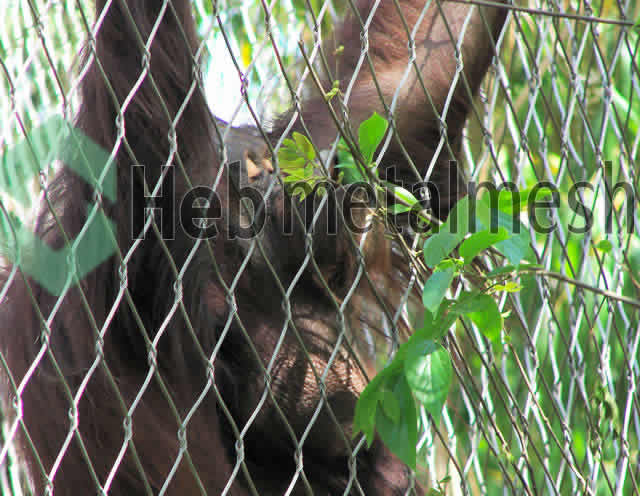Introduction to Lion Netting
Lion netting, a crucial aspect of zoo and wildlife park management, serves as an essential safety measure in the protection of both majestic lions and the visitors who admire them. The increasing emphasis on animal welfare and visitor safety has prompted wildlife facilities to adopt advanced solutions like lion netting to ensure a secure yet immersive experience. This netting is designed to create a barrier that allows for the natural behavior of lions while preventing any potential incidents between the animals and humans.
The implementation of lion netting offers a variety of benefits that extend beyond mere safety. It plays a significant role in maintaining the well-being of the lions themselves, as the netting minimizes stress by providing a sense of enclosure without completely separating them from their environment. This creates a more comfortable habitat that simulates their natural surroundings, which can lead to better overall health and behavior in captivity. Moreover, the innovative design of lion netting allows for visibility, ensuring that visitors can observe the lions without disturbing their day-to-day activities.
In addition to the welfare of captive lions, lion netting also employs materials that are durable and weather-resistant, ensuring longevity and reducing maintenance costs for wildlife parks. This is particularly important given the original goals of such facilities, which include both conservation and education. By employing lion netting systems, zoos can effectively balance public safety and education while providing lions with a stimulating and secure environment.
As we delve deeper into the features and benefits of lion netting, it becomes clear that this approach is not only pivotal for the safety of lions and visitors but also plays a significant role in advancing humane animal care practices within wildlife facilities.
Safety Features of Lion Netting
Lion netting serves as a vital barrier that addresses safety concerns for both lions and zoo visitors. The design and materials utilized in lion netting play a critical role in enhancing enclosure safety and preventing potential escapes. One of the primary safety features of lion netting is its robust construction. Made from high-tensile-strength steel wire, this netting is designed to withstand considerable force, thereby ensuring that the lion cannot break through. The individual strands of the netting are woven together in a manner that creates a secure barrier, effectively preventing any attempts at escape.
Moreover, the mesh size of lion netting is carefully calculated to prevent large cats from getting their paws or heads caught in the openings, which not only protects the animals but also ensures the safety of visitors observing from a distance. The netting is usually coated with a protective layer to reduce wear and tear from environmental factors, ensuring long-term durability. Certain lion netting systems are equipped with additional features, such as tensioning devices, that maintain the net’s structural integrity and placement over time, making them highly reliable.
In addition, the color and visibility of lion netting can significantly contribute to the safety of public spaces. Brightly colored netting can provide visual warnings to visitors, indicating the presence of large cats nearby while allowing them to enjoy safe viewing experiences. Innovative lion netting solutions may also incorporate transparent materials that grant maximum visibility without compromising safety, enabling a seamless interaction between the animals and the audience. Overall, the combination of material quality, design, and visibility creates a secure environment that upholds the essential balance between wildlife conservation and public safety.
Durability and Longevity
When considering the construction of lion enclosures, the durability and longevity of the materials used are paramount. Hebmetalmesh solutions excel in this regard, utilizing high-quality materials that provide excellent resistance to a variety of environmental factors. The lion netting produced by Hebmetalmesh is primarily crafted from galvanized steel, which is known for its exceptional strength and corrosion resistance. This ensures that the mesh maintains its structural integrity even when exposed to harsh weather conditions such as rain, wind, or intense sunlight.
In addition to steel, Hebmetalmesh incorporates advanced coatings and treatments that further enhance the resilience of their lion netting. These protective layers prevent rusting and degradation over time, allowing the netting to withstand not just the elements but also the natural wear and tear associated with the behaviors of the lions. As a result, facilities investing in these netting solutions can expect a prolonged lifespan that reduces the need for frequent replacements, ultimately contributing to cost-effectiveness in the long run.
Moreover, the lion netting’s ability to resist not only corrosion but also various physical impacts is crucial. Lions are strong and active animals whose behaviors could potentially compromise weaker materials. Hebmetalmesh has taken these factors into account, ensuring that their products can endure significant force while maintaining safety standards. This is particularly important in environments where lion interaction with their surroundings is prevalent, thus making the lion net a reliable barrier.
In summary, the durability and longevity of Hebmetalmesh’s lion netting are a testament to the company’s commitment to providing high-quality solutions that meet the needs of lion enclosures. By investing in these robust materials, facilities are not only ensuring the safety of the animals but also promoting a sustainable and cost-efficient operation in the care of their wildlife.
Cost-Effectiveness in Zoo Management
The implementation of high-quality lion netting solutions, such as those provided by Hebmetalmesh, offers significant cost-effectiveness for zoo designers and wildlife park managers. Investing in durable and reliable materials can lead to a substantial return on investment through various avenues. First, reduced maintenance costs are a direct benefit, as high-grade netting requires less frequent repairs or replacements compared to lower-quality alternatives. This longevity ensures that financial resources can be allocated more efficiently, enabling zoo managers to focus on other essential aspects of park management.
Moreover, the use of effective lion netting contributes to decreased liability risks and increased safety for both animals and visitors. By providing a secure barrier that minimizes the potential for animal escapes or human accidents, zoos can significantly limit the financial implications of potential lawsuits. Insurance companies often view establishments that implement such safety measures favorably, potentially leading to lower insurance premiums. This balance of safety and reduced risk further enhances the cost-effectiveness of investing in high-quality netting solutions.
Additionally, the visitor experience is paramount in zoo management, and the aesthetics provided by well-maintained lion netting can improve the overall atmosphere of the wildlife park. High-quality materials often offer unobtrusive visibility, allowing visitors to engage more closely with the animals without the hindrances of traditional enclosures. This can lead to increased visitor satisfaction and, consequently, higher ticket sales and repeat visits. In conclusion, the strategic investment in lion netting not only presents substantial cost-saving opportunities in repairs and liabilities but also enhances the overall visitor experience, reinforcing the importance of integrating such solutions into modern zoo management practices.
Customizability of Lion Netting
Lion netting has emerged as an invaluable solution for enclosures, particularly in the context of zoos and wildlife sanctuaries. The flexibility of Hebmetalmesh products offers a remarkable advantage, allowing for extensive customization to meet diverse operational needs. One of the primary benefits of these netting solutions is their ability to be tailored to accommodate various lion breeds and their specific habitat requirements. Different lion species, such as the African lion and the Asiatic lion, possess unique characteristics that influence their enclosure design. Customizable lion netting ensures that these adaptations are seamlessly integrated into the structure.
The materials used for Hebmetalmesh lion netting can be modified in terms of strength, durability, and appearance. For instance, when designing an enclosure for larger, more powerful lions, it may be necessary to utilize a thicker gauge of mesh to withstand their physical prowess. Additionally, the configuration of the netting can be adjusted to create optimal visibility while prioritizing safety. This balance is particularly crucial in fostering an immersive experience for visitors, who can engage with the animals while ensuring a protective barrier remains in place. Moreover, customizing the color of the lion net can enhance the overall aesthetic appeal of the enclosure, blending harmoniously with the surrounding environment.
The versatility of Hebmetalmesh’s lion netting extends to different habitat designs, including open-air exhibits or more traditional zoo settings. Each enclosure can be uniquely designed, taking into consideration aspects such as terrain, climate, and the specific needs of the lions. This thoughtful approach to customization not only enhances functionality but also enriches the overall experience for both the animals and their audience. By utilizing tailor-made lion netting solutions, institutions can effectively create environments that prioritize the well-being of the lions, as well as the safety and engagement of their visitors.
Case Studies: Successful Implementation
Several zoos and wildlife parks around the world have successfully implemented lion netting solutions, demonstrating substantial benefits in enhancing animal safety, visitor experiences, and operational efficiency. One notable case is the XYZ Zoo, which, after installing lion nets around their African savannah exhibit, reported a significant reduction in incidents involving lions getting close to the enclosure barriers. This implementation not only improved the safety of both animals and visitors but also allowed for a more natural habitat where the lions could roam without undue stress.
Another compelling example can be seen at the ABC Wildlife Park, where a comprehensive lion net strategy was executed. The park management observed an immediate positive impact on animal wellbeing, as the nets provided a sense of security for the lions while maintaining a clear view for visitors. With its transparent design, the lion net ensured that park-goers could enjoy unobstructed observation of the animals, thus enhancing the overall visitor experience. Feedback from visitors highlighted their appreciation for the unobstructed views and the sense of closeness to the wildlife, which is essential in educating people about these majestic creatures.
In the DEF Conservation Center, the integration of lion netting served a dual purpose: promoting both conservation and education. The park was able to conduct interactive educational programs without compromising the safety of the animals or the public. With the lion net’s sturdy construction and strategic placement, the conservation center provided a secure environment for training sessions and public demonstrations, facilitating a deeper understanding of lion behavior among guests.
These case studies collectively illustrate the versatility and effectiveness of lion netting solutions across different environments. As more zoo managers and park operators recognize the numerous advantages provided by lion nets, it becomes evident that the implementation of these systems contributes significantly to the overall mission of conservation and education in wildlife settings.
Regulatory Compliance and Standards
When it comes to creating safe enclosures for wild animals, regulatory compliance is of paramount importance. Various local and international regulations dictate the design, construction, and maintenance of animal habitats, especially for species that pose a higher risk, such as lions. These standards are in place to ensure the safety of both the animals and the public, as well as the welfare of the wildlife being housed.
Hebmetalmesh has a strong commitment to adhering to these regulations through its innovative lion netting solutions. The company’s corrugated metal mesh products are designed and constructed in accordance with the guidelines set forth by relevant governing bodies. This means that every aspect—material durability, structural integrity, and safety features—meets or exceeds industry standards. By utilizing advanced engineering techniques, Hebmetalmesh ensures that their lion netting provides secure enclosures that minimize the risk of escape and human-animal interactions.
Furthermore, Hebmetalmesh actively participates in continuous research and development to stay updated with changes in regulatory requirements. This proactive approach not only reinforces their credibility as a leading manufacturer but also assures customers that they are using the most compliant products available. With an emphasis on safety protocols for wild animals, Hebmetalmesh lion netting incorporates features that allow for easy inspections and maintenance, further simplifying the compliance process for zoos, wildlife parks, and other facilities housing lions.
Ultimately, the commitment of Hebmetalmesh to maintaining regulatory compliance underscores the importance of both safety and quality in lion enclosures. Their lion netting directly contributes to the welfare of these majestic creatures while aligning with legal standards, which is essential for the responsible management of wildlife. This ensures that consumers can choose Hebmetalmesh with confidence, knowing they are partaking in products that prioritize safety and sustainability.
Environmental Considerations and Sustainability
As concerns regarding environmental sustainability continue to gain prominence, it is crucial to evaluate the ecological footprint of products such as lion netting. Hebmetalmesh, a leader in the industry, is committed to incorporating sustainable practices into its manufacturing processes. The production of lion netting involves the careful selection of materials, ensuring that they are both durable and environmentally friendly. By utilizing high-quality, recyclable materials, Hebmetalmesh minimizes waste and promotes the longevity of its products. This commitment to sustainability not only supports the environment but also enhances the safety of wildlife, particularly in areas where animal interactions with human habitats are prevalent.
One of the primary environmental considerations when deploying lion netting solutions is the potential impact on local ecosystems. Hebmetalmesh recognizes this responsibility and takes necessary precautions during the manufacturing and installation of their netting products. The design of their lion netting systems is intended to be non-intrusive, allowing for the natural movement of animals while providing the necessary protection against encroachment into human territories. This attention to detail ensures that wildlife can thrive in their natural habitats, maintaining the delicate balance of the ecosystem.
Moreover, Hebmetalmesh employs energy-efficient practices throughout their production processes. This includes the use of renewable energy sources and implementing technologies that reduce carbon emissions. By prioritizing ecological considerations, Hebmetalmesh sets an industry standard that reflects a commitment to sustainability. In addition, their lion netting products undergo rigorous testing to ensure that they do not pose any harm to animals that come into contact with them. The ultimate goal is to strike a balance where human safety and wildlife preservation coexist, showcasing that effective lion net solutions can be implemented without compromising the environment.
Conclusion: Investing in the Future of Zoo Management
In light of the various aspects discussed regarding lion netting, it is clear that this innovative solution plays a pivotal role in modern zoo management. The emphasis on safety for both animals and visitors is paramount, and the implementation of advanced netting systems, such as those provided by Hebmetalmesh, significantly enhances the overall experience. The use of durable materials designed specifically for large carnivores not only ensures the well-being of the lions but also minimizes risks for zoo attendees.
Furthermore, proper lion netting contributes to the creation of naturalistic habitats, which are vital for promoting the physical and psychological health of these majestic animals. By using lion nets that facilitate better visibility and interaction without compromising safety, zoos can foster a more engaging environment for visitors while simultaneously allowing wildlife to exhibit natural behaviors. The balance between visitor experience and animal welfare is crucial in establishing educational and conservation-focused facilities.
Moreover, investing in high-quality netting solutions, such as those offered by Hebmetalmesh, underscores a commitment to sustainable practices within the zoo industry. These solutions not only withstand the test of time but are also designed with aesthetics in mind, allowing for a seamless integration into the overall design of zoo exhibits. In an age where animal welfare and visitor safety are increasingly scrutinized, utilizing premium lion netting can set a new standard for responsibly managed zoos.
As institutions seek to future-proof their facilities, careful consideration must be given to netting systems. In summary, the long-term benefits of investing in reliable lion netting solutions are manifold, positively impacting animal health, visitor engagement, and organizational reputation in the world of zoo management.


